
Fish tanks line the walls of a second-floor lab in the Biology-Psychology Building. Swimming in some are little silver tetras that look fit for a common fishbowl. In others, there are creatures that appear more like a pet store’s Halloween special — pale and alien, with slight streaks of translucent pink and, most notably, no eyes.
While their looks don’t give it away, these two kinds of fish are actually the same species, biological cousins separated by only a few million years spent in different settings: one in surface streams and the other in the total dark of caves.
In a study published in Nature Communications on Oct. 20, researchers from this university sequenced the genome of the blind cave fish variety of the Mexican tetra to determine what in their DNA makes them so different from their surface-dwelling counterparts.
William Jeffery, a biology professor and co-author of this study, said the Mexican tetras provide a unique opportunity for researchers to study what genetic changes cause such drastic physical differences, which evolved in such a short time period.
By cross-breeding the cave and surface fish and studying hybrid fish with a particular trait, researchers are able to determine which areas of the genome are statistically associated with a particular trait, said Eric Haag, a university biology professor who was not involved in the study.
Each of these sections of the genome has many genes, but this study, Jeffery said, helps narrow down the possibilities of genes that produce the change. By looking at the areas they know are associated with the changes in the eye and pigmentation, the researchers were able to find the genes likely responsible for the differences.
Not only can this show the genetic basis of the eye degeneration in these fish, but it also can give scientists insight into degenerative eye conditions affecting humans, including vacuolar degeneration, cataracts and myopia, Jeffery said.
“It gives us this opportunity to see the entire repertoire of genes that may be affected in the degeneration of an eye, and those are the genes that are actually the substance for many diseases in humans,” he said.
Research involving the interplay between genetics and physical traits is often quite difficult, said Amy Parkhurst, a post-doctoral research assistant and manager of The Jeffery Lab. But the fact that both ancestral and evolved forms of the fish coexist and can be crossbred makes the work much easier.
“In science, when you want to study the direct link of phenotype, which is the physical characteristic, and genotype, which is the underlying genetics, normally you have to spend all this time and all this effort trying to knock out or change the gene you want and then create a line of animals that then reproduces consistently with that trait so you can study it,” she said. “In this case, nature has done all the work for us.”
Though the cave fishes’ loss of eyes may seem like devolution, eyelessness is not a problem for them; they actually benefit from the evolutionary quirk.
The same genes that cause eye loss might help the fish in other ways, such as an increased sense of smell and a greater ability to sense vibrations in the water because of an increased number of hair cells on their lateral line, Jeffery said.
Amy Parkhurst, a post-doctoral research assistant and manager of The Jeffery Lab, demonstrated the fishes’ ability by dropping a flake of food into a tank in the lab. The eyeless fish flocked to the point where they sensed the vibration.
They needed to adapt to the caves quickly, and such traits helped them do so.
Several subspecies of these cave fishactually evolved independently of one another, Jeffery said, and cross-breeding them reveals how different genes account for the blindness even among other populations of fish.
“If you take one eyeless cave fish strain and cross it with another eyeless cave fish strain, the outcome of that is the progeny has eyes,” he said. “So that means that different genes were lost in the two different cave fish strains, resulting in the loss of the eye but for two different reasons.”
For this study, the actual genetic sequencing occurred at the University of Minnesota and other locations, but Jeffery and his lab provided the sample DNA from their stock of fish. They have about 1,800, Parkhurst said, but they can hold a maximum of 3,000 in their lab.
To collect the fish, Jeffery, Parkhurst and others have made many trips to Mexico, where they go to isolated villages and valleys in search of caves and fish to bring back.
Finding their habitats is hard work that sometimes involves negotiating with locals to visit caves in their backyards or spelunking down 300-foot drops, she said.
But catching the cave fish is easy, Parkhurst said: All they need are corn tortillas. The fish apparently have a taste for the regional cuisine, and when the net approaches, they never see it coming.



